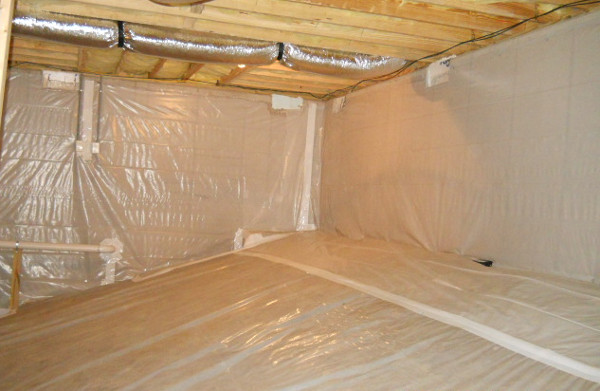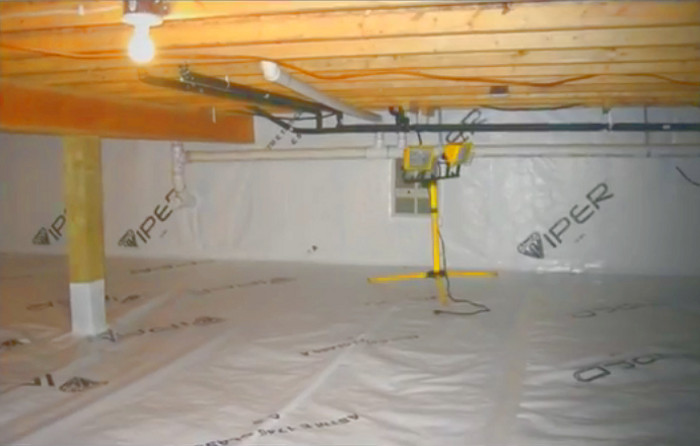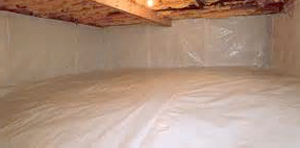10 mil vapor barrier: that’s probably not exciting news to you if you’re not an Architect or Contractor. Yawn… However, if you ARE an Architect or Contractor, this is big news.
HISTORY OF VAPOR BARRIERS SINCE THE LAST CENTURY
This is a big shift from something most Engineers, Architects and Builders have been using for decades: 6 mil polyethylene. Where is this used? Typically under concrete slabs where the concrete is inside interior space, including at garages and basements. Also, polyethylene is usually the vapor barrier used over earth (i.e.: dirt) under your house’s crawlspace. And here is where things start getting interesting.
Continued, below:

For decades (at least since the early 1970s when this Architect began designing projects) 6 mil polyethylene has been the standard material and thickness used to cover the dirt under a concrete slab and to seal off a crawlspace. So what’s happened to result in a change to a thicker material (to 10 mil)?
WHAT’S THE PROBLEM WITH THE OLD STANDBY?
Simple: the old standard isn’t and hasn’t ever worked very well. The 6 mil material is too easily torn by the rough treatment it receives when workers drag steel reinforcing bars across it, tromp around on it in construction boots, cut materials on it, drive over it, drag boards across it and a host of other abuse it simply doesn’t have the resistance to handle successfully.
So what’s been happening to the old standard 6 mil polyethylene? In a word: damage: tears, punctures, holes, abrasions and other breeches that allow moisture (i.e.: water) from underneath the vapor barrier to enter above the barrier and then migrate around up through the concrete slab (where one exists), and into crawlspaces. This results in mold growth, water damage, and infestations. What sort of infestations? Bugs and rodents, primarily.
MERITS OF A THICKER VAPOR BARRIER
If you have a wonderfully secure, continuous plastic vapor barrier separating the ground from a concrete slab and/or a crawlspace, it is just about impossible to have bugs and mice in your house. Thick plastic is not appetizing to insects, spiders and vermin. There are easier pickings at your neighbor’s house, so they go over there and tend to leave you alone. If you have no holes through which pests can enter your house, they typically won’t work very hard at trying to gain access. The same goes for radon gas and other things that are bad for people and their pets, that you don’t want to allow to enter your living space. The primary battlefront is in your basement and/or crawlspace. If you have a better barrier there, then you stand a much better chance of having a drier, cleaner and healthier house above it. And having a thicker vapor barrier means that it will be stronger, and less likely to tear and be punctured by construction activities.
continued below:

The answer? Going to 10 mils thickness instead of the old 6 mils.
TECHNICAL REFERENCES CITING IMPROVED STANDARDS
Recently, Mr. Bobby Haines, P.E., S.E. of CSA Engineering (a Knoxville, TN structural engineering company working with the HOME ARCHITECTS on a project in Tennessee), referenced ASTM E1745-09 and ACI 302.1 R-04. While the ASTM reference doesn’t actually call out the mil thickness, it does indicate Type A, B and C vapor Barriers. What is most interesting are the comments from the references ACI section, in which Mr. Haines indicated:
“Although conventional polyethylene film with a thickness of as little as 6 mils has been used, the committee strongly recommends that the material be in compliance with ASTM E 1745 and that the thickness be no less than 10 Mils. The increased thickness offers increased resistance to moisture transmission while providing greater durability during and after installation”.
Mr. Haines added: “Typically, 6 mil vapor barriers are class C according to ASTM E1745. Typically, 10 mil vapor barriers fall into the “Class A” category.” This is due to the fact that the E1745 classifications mainly vary in their puncture and tear resistance.
Therefore, engineering disciplines have made the shift to the thicker 10 mil polyethylene. And so now, one of the leading residential Architects in the USA announces its decision to follow their advice.
What is interesting when reading ASTM E1745-09, is that, in addition to the other information, they indicate, in subsection 7.4.1 Flame Spread, that Class A membranes are 0-25, Class B 26-75, and Class C 76-200. (Lower = less flame spread= less combustible). Therefore, those membranes that are thicker in the Class A category appear to have a lower flame spread. In a followup conversation with a major manufacturer of vapor barrier polyethlyene, Rand Soellner, Senior Staff Architect for the HOME ARCHITECTS documented them indicating that the thicker membranes tend to melt when heat is applied to them, often not burning until reaching a temperature of around 350*F. Note: if any humans happened to be in a house when this temperature was reached, they would not be with us any longer to be affected by any ensuing combustion. That appears to mean that the thicker vapor barriers tend to perform better in terms of combustibility (although anyone researching membranes should document the characteristics of what they intend to use).

FLAME SPREAD
What’s the interesting point about this? Well just this: homes are classified by the IBC (International Building Code) as Type V (B) (combustible). In other words, houses are allowed to be built of flammable materials. While this may be allowed by Code, and carried through in the IRC (International Residential Code), anything an Architect can do to minimize flammability and risk of fires spreading, while not technically required in all circumstance (except a few), would be a good idea. Therefore, if you have a crawlspace under the majority of the house and you can select a thicker vapor barrier that apparently is less flammable than thinner membranes, it makes sense to choose that and to specify that.
And that is exactly what this architectural firm is doing.
IMPROVED COLOR FOR IMPROVED VISIBILITY
And, if you’re going to do that, you might as well also make the 10 mil polyethylene white in color. Why? Because white reflects light better, so when you go down into your crawlspace to perform some task, maintain an air handler or whatever, the lights you turn on down there and the flashlight in your hand makes the crawlspace more visible to you. You can also spot imperfections, like tears or punctures, or creepy-crawlies, and fix the problems swiftly by being able to locate them immediately.
VALUE/BUDGET
Can you do more and pay more for even better vapor barriers? Yes you can: you can obtain thicker membranes and some of them offer reinforcing fibers built into the membrane, improving its strength. However, the cost of such much thicker membranes can result in the crawlspace encapsulation costing thousands of dollars more than using the 6 mil membrane. Therefore, this architectural firm has made the decision to select a middle of the road solution for their Clients: better and thicker than has been used for the last several decades, but not the Rolls Royce version. The hoped-for result: that this firm’s Clients receive an improved Value: for just a little bit more in material cost, they gain a much better crawlspace containment.
ENCAPSULATION
Check out this related online article from this firm: Crawlspace Encapsulation. That is most enlightening. Read more there to find out about this highly desirable practice (available on most projects from this company).
Contact: Rand@HomeArchitects.com 828-269-9046 for one of best residential designs available in the United States today.
www.HomeArchitects.com
tags: Cashiers, Highlands, Lake Toxaway, Asheville, Hendersonville, Atlanta, Glenville, Lake Wales, Newnan, Daytona, Aspen, Telluride, Lake Tahoe, Rocky Mountains, Colorado.
